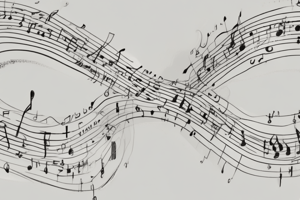Podcast
Questions and Answers
What is the key signature for C Major?
What is the key signature for C Major?
- No Sharps/Flats (correct)
- 1 Sharp
- 1 Flat
- 2 Sharps
What is the key signature for G Major?
What is the key signature for G Major?
- 1 Flat
- 1 Sharp (correct)
- No Sharps/Flats
- 2 Sharps
What is the key signature for D Major?
What is the key signature for D Major?
- 3 Sharps
- No Sharps/Flats
- 2 Sharps (correct)
- 1 Sharp
What is the key signature for A Major?
What is the key signature for A Major?
What is the key signature for E Major?
What is the key signature for E Major?
What is the key signature for B Major?
What is the key signature for B Major?
What is the key signature for F# Major?
What is the key signature for F# Major?
What is the key signature for C# Major?
What is the key signature for C# Major?
What is the key signature for F Major?
What is the key signature for F Major?
What is the key signature for B♭ Major?
What is the key signature for B♭ Major?
What is the key signature for E♭ Major?
What is the key signature for E♭ Major?
What is the key signature for A♭ Major?
What is the key signature for A♭ Major?
What is the key signature for D♭ Major?
What is the key signature for D♭ Major?
What is the key signature for G♭ Major?
What is the key signature for G♭ Major?
What is the key signature for C♭ Major?
What is the key signature for C♭ Major?
How do you find intervals?
How do you find intervals?
How do you find interval inversions?
How do you find interval inversions?
Name the interval qualities from smallest to largest.
Name the interval qualities from smallest to largest.
What is Natural Minor?
What is Natural Minor?
What is Harmonic Minor?
What is Harmonic Minor?
What is Melodic Minor?
What is Melodic Minor?
How do you find the relative minor?
How do you find the relative minor?
How do you find the relative major?
How do you find the relative major?
What is the Diatonic Series for Major?
What is the Diatonic Series for Major?
What is the Diatonic Series for Minor?
What is the Diatonic Series for Minor?
What is the Harmonic Motion Pull Chart for Major?
What is the Harmonic Motion Pull Chart for Major?
What is the Harmonic Motion Pull Chart for Minor?
What is the Harmonic Motion Pull Chart for Minor?
What is Parallel Minor?
What is Parallel Minor?
What is Figured Bass?
What is Figured Bass?
What are the inversion symbols for Triads?
What are the inversion symbols for Triads?
What are the inversion symbols for 7th Chords?
What are the inversion symbols for 7th Chords?
What do accidentals or slashes in figured bass mean?
What do accidentals or slashes in figured bass mean?
What is the interval pattern for Dominant 7th Chords?
What is the interval pattern for Dominant 7th Chords?
What is the interval pattern for Major 7th Chords?
What is the interval pattern for Major 7th Chords?
What is the interval pattern for Minor 7th Chords?
What is the interval pattern for Minor 7th Chords?
What is the interval pattern for Half Diminished 7th Chords?
What is the interval pattern for Half Diminished 7th Chords?
What is the interval pattern for Fully Diminished 7th Chords?
What is the interval pattern for Fully Diminished 7th Chords?
What is a Progression (P)?
What is a Progression (P)?
What is Elision?
What is Elision?
What is Retrogression (R)?
What is Retrogression (R)?
What is Repetition (S)?
What is Repetition (S)?
What is Modal Music?
What is Modal Music?
What is Tonal Music?
What is Tonal Music?
Name the Scale Degree Names in Order.
Name the Scale Degree Names in Order.
What is a Cadence?
What is a Cadence?
What is a Perfect Authentic Cadence (PAC)?
What is a Perfect Authentic Cadence (PAC)?
Flashcards are hidden until you start studying
Study Notes
Key Signatures with Corresponding Minor Scales
- C Major has no sharps or flats; its relative minor is A minor.
- G Major contains 1 sharp; its relative minor is E minor.
- D Major features 2 sharps; its relative minor is B minor.
- A Major includes 3 sharps; its relative minor is F# minor.
- E Major has 4 sharps; its relative minor is C# minor.
- B Major contains 5 sharps; its relative minor is G# minor.
- F# Major features 6 sharps; its relative minor is D# minor.
- C# Major has 7 sharps; its relative minor is A# minor.
- F Major has 1 flat; its relative minor is D minor.
- B♭ Major contains 2 flats; its relative minor is G minor.
- E♭ Major features 3 flats; its relative minor is C minor.
- A♭ Major has 4 flats; its relative minor is F minor.
- D♭ Major contains 5 flats; its relative minor is B♭ minor.
- G♭ Major features 6 flats; its relative minor is E♭ minor.
- C♭ Major has 7 flats; its relative minor is A♭ minor.
Intervals and Their Qualities
- To determine intervals, count the letter names between the starting and ending notes, then count half steps.
- An even number of half steps indicates a minor interval; an odd number indicates a major interval.
- For interval inversions, subtract the interval's value from 9 and switch its quality: Major to minor, perfect stays perfect, augmented becomes diminished and vice versa.
Types of Minor Scales
- Natural Minor aligns with the same key signature as its relative major with no raised notes.
- Harmonic Minor raises the 7th degree, creating a leading tone.
- Melodic Minor raises both the 6th and 7th degrees on ascension and lowers them on descension.
Finding Relative Major and Minor
- Relative minor can be found by counting 4 half steps down from the tonic of the major scale.
- Relative major can be found by counting 4 half steps up from the tonic of the minor scale.
Diatonic Series
- Major Scale Degrees: I-ii-iii-IV-V-vi-vii*-I
- Minor Scale Degrees: i-ii*-III-iv-V-VI-vii*-i
Harmonic Motion Pull Chart
- Major Progressions: iii-vi/ii, ii*-IV-IV-V, V⁷/vii⁷-I
- Minor Progressions: III-VI/ii*,iv, ii⁷-V, V⁷/vii*, vii⁷-I
Chord and Figured Bass Inversions
- Triads:
- Root Position: 5/3
- First Inversion: 6 or 6/3
- Second Inversion: 6/4
- 7th Chords:
- Root Position: 7
- 1st Inversion: 6/5
- 2nd Inversion: 4/3
- 3rd Inversion: 4/2
Accidentals in Figured Bass
- Accidentals apply to the notes above the bass line, with slashes indicating raises.
Chord Patterns
- Dominant 7th: Major/minor/minor
- Major 7th: Major/Major/Major
- Minor 7th: minor/Major/minor
- Half Diminished 7th: minor/minor/Major
- Fully Diminished 7th: minor/minor/minor
Types of Harmonic Progressions
- Progression (P) indicates forward motion.
- Elision skips chords on the pull chart.
- Retrogression (R) denotes backward motion.
- Repetition (S) repeats a chord functionally.
Types of Music
- Modal Music is centered on scales without a key.
- Tonal Music is based around a key, typically starting and ending on the tonic.
Scale Degree Names
- 1: Tonic
- 2: Supertonic
- 3: Mediant
- 4: Subdominant
- 5: Dominant
- 6: Submediant
- 7: Leading Tone
- 8: Tonic
Cadences
- Cadences serve as musical punctuation marking the end of a phrase, often consisting of a two-chord progression.
- Perfect Authentic Cadence (PAC) denotes a strong resolution.
Studying That Suits You
Use AI to generate personalized quizzes and flashcards to suit your learning preferences.




